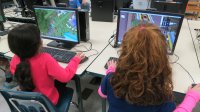Inspiring Young Writers With Minecraft
Using a topic of great interest to students, like a popular video game, is a handy way to get them writing.
In 2015 Elijah C. Stroud published The Story of My Minecraft Life on Amazon. Available for Kindle and in paperback, it recounts Stroud and his friend’s journey playing and building in the blocky game environment. Stroud followed it up with The Last Day of Minecraft, which came out in early 2016. According to the description on Amazon, the sequel introduces “Elijah’s fictitious brother, Evan. Together the two get into a wild adventure in the world of Minecraft.”
In addition to authoring two books, Stroud has a YouTube channel devoted to Minecraft. Oh, and did I mention that he was just 8 years old at the time of his first book’s publication?
“This kid is now really excited about writing, which is fantastic,” The New York Times best-selling author Mark Cheverton told me. Cheverton has written dozens of unofficial Minecraft books in the Gameknight999 series. Stroud had sent him stories prior to publishing on Amazon. “It doesn’t matter how good it is—it matters that he’s not afraid to write!”
Cheverton is a retired physics teacher living in upstate New York. Shortly after retirement, he began to write Minecraft fiction. “I put the books up online just to see what would happen,” he recalled. At the time, most Minecraft books were how-to manuals, not novelizations. Now, there are many unofficial Minecraft books (stories set in the game world but not authorized by Mojang or its parent company, Microsoft). Sean Fay Wolfe is another Minecraft novelist. He has already written four books in the series The Elementia Chronicles, published by HarperCollins, and he is just 19 years old.
Interest-Driven Reading
Cheverton’s books score at a seventh- or eighth-grade reading level on the Lexile range, the framework that helps match grade levels to reading ability. Yet 7-year-old children read his books—albeit with guidance from their parents. “When a child likes something like Minecraft, they become highly motivated to read these types of books,” Cheverton told me. “What I’ve learned from teaching is that kids tend to rise to our expectations. If you say they are a fourth-grade class and should only read fourth-grade stuff, then you’re not challenging them to read higher.”
Cheverton’s first book enjoyed a “voracious reception” from kids. “My books take readers on an immersive journey through the world of Minecraft,” he explained. “They feel like they’re in it. They can imagine themselves as the main character. Kids want that extra dimension, reading it and feeling it.”
A Toolkit for Aspiring Authors
Over the past two years, Cheverton has received about 480 stories from young readers. Here are a few examples, written by kids between the ages of 8 and 11 who use the pseudonyms stampyfan£, DerpyBunny1, and Ally.
“There’s a skill to writing we don’t really teach in schools,” Cheverton explained. “We teach grammar. We do get the hero’s journey—sometimes. But nobody talks about how to write dialogue. There’s a science to it. These are great things for kids to learn.”
As a former engineer, Cheverton has a scientist’s mind. As a writer, he felt that he needed a formula to guide his stories. Every chapter he writes is like a scene in a movie, with a flow, pacing, and strategy to it. To learn how to write fiction, Cheverton studied books on character development and dialogue. He read Fire of Fiction, a book that shows how to introduce tension into a story.
Cheverton next created teaching resources, which are freely available on his website. They are a treasure trove of educational writing materials, including guides on story elements and plot development. There are also downloadable lesson plan ideas for teachers.
Make Writing Relevant
Minecraft is relevant to many students, but not all students love Minecraft. Many in my middle school class love other games, like Undertale. And others don’t play many games at all. When assigning writing projects to students, allow for student choice. Students should have freedom to follow their passions. “Because kids feel like such a content expert, they feel safer to write,” Cheverton said. “I think that’s the real key with Minecraft.”
Self-publishing books is an authentic, real-world activity to have students do. Try using iBooks Author, Book Creator, or the free Kindle resources from Amazon in your class. Please share in the comments below your ideas to get children to publish books.
